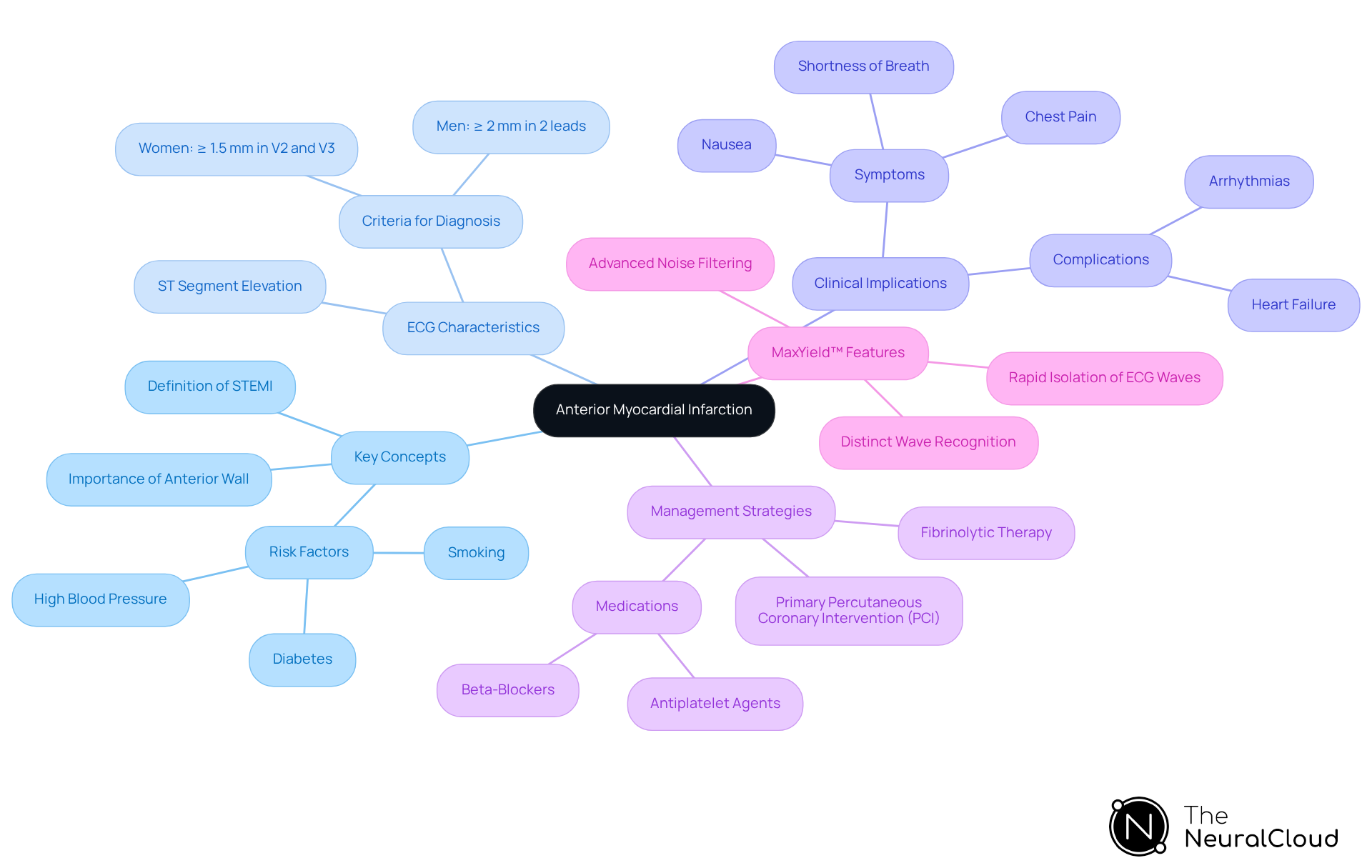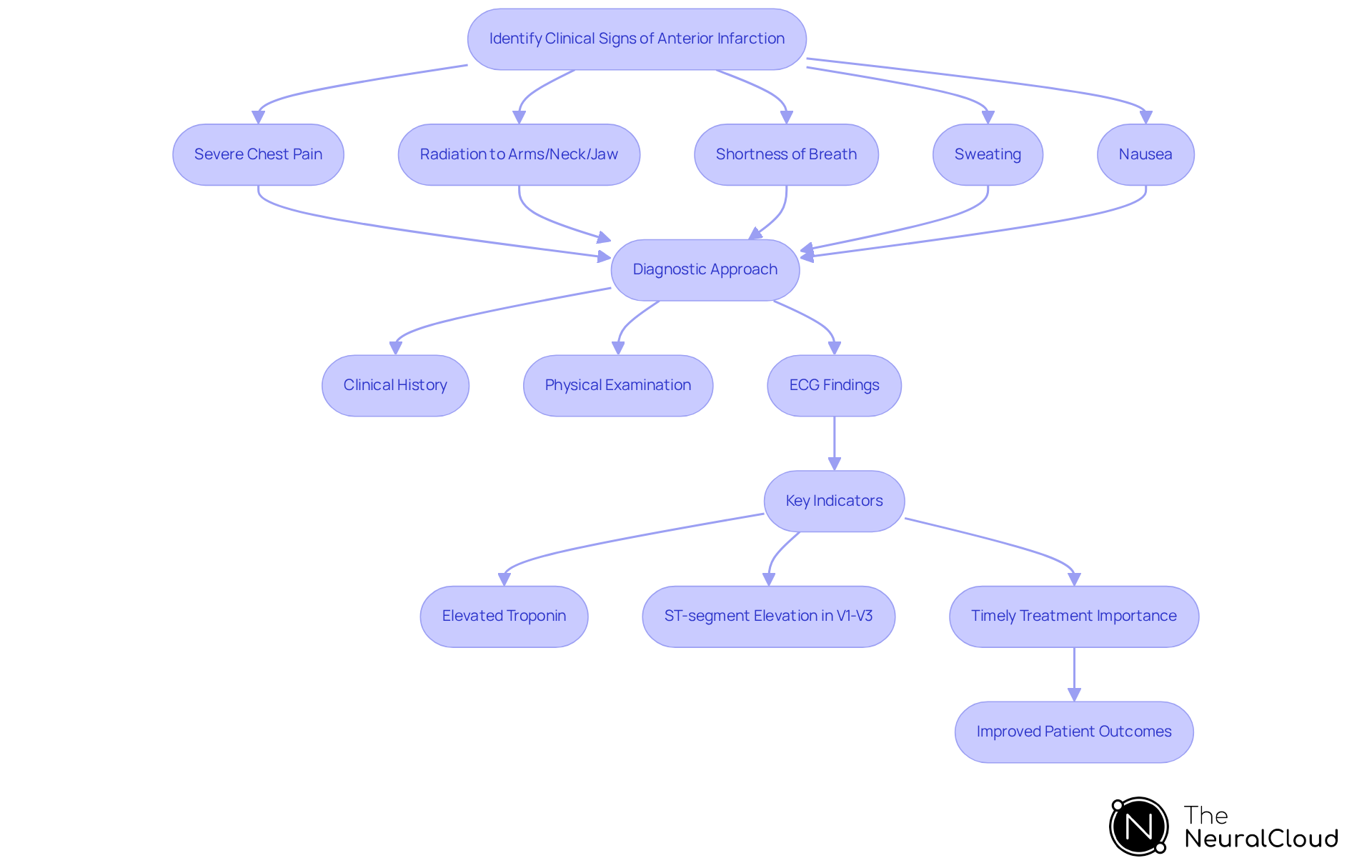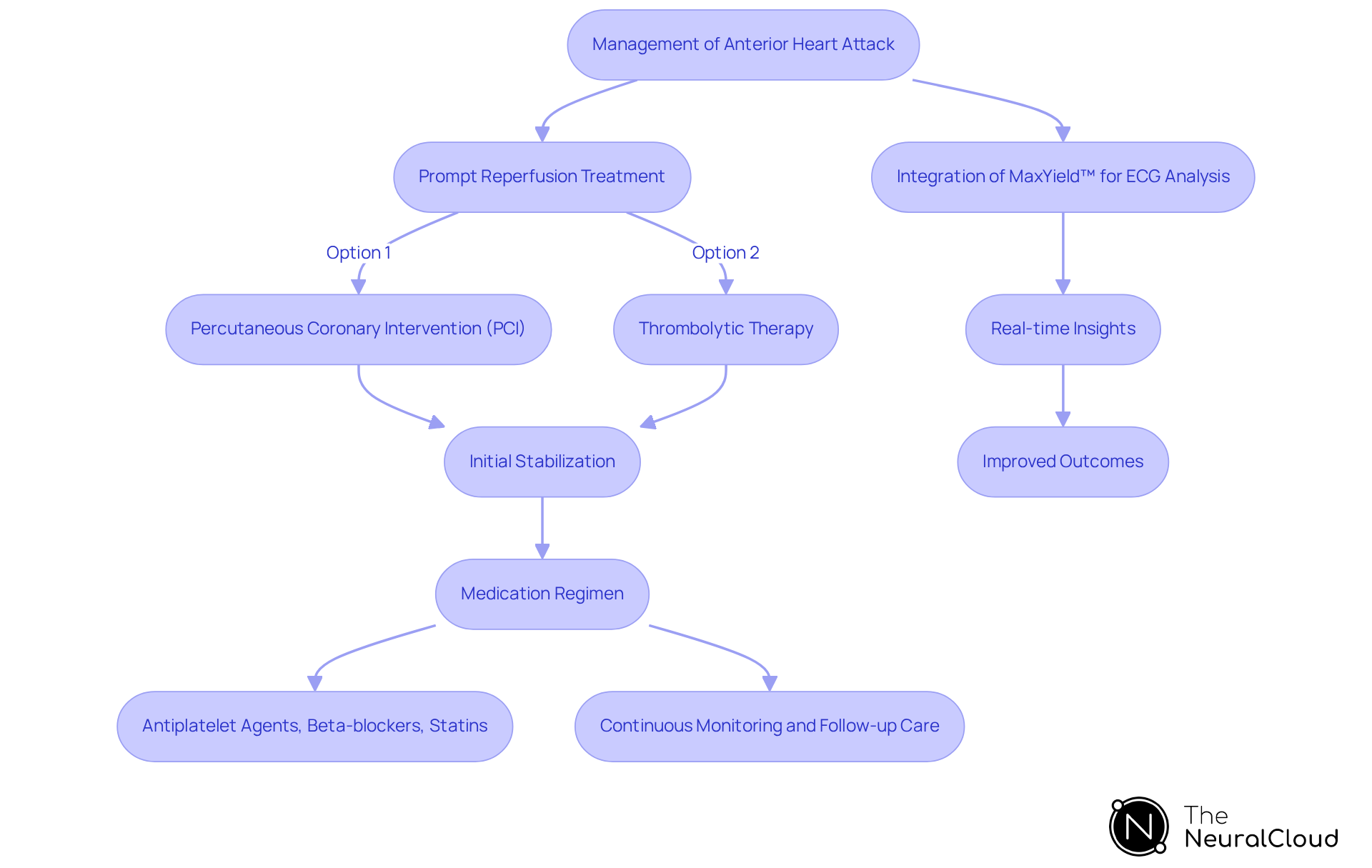Overview
Anterior infarcts pose significant risks as they can severely compromise heart function, resulting in complications such as heart failure and arrhythmias. This is primarily due to blockages in the left anterior descending artery. The article underscores the critical role of the anterior wall in cardiac pumping, highlighting the necessity for timely intervention. Furthermore, it emphasizes the importance of advanced diagnostic tools, such as the MaxYield™ platform, in enhancing patient outcomes for those experiencing anterior myocardial infarction.
The MaxYield™ platform addresses challenges in ECG analysis by offering features that improve the accuracy and speed of diagnosis. This platform enhances ECG interpretation, allowing healthcare professionals to make informed decisions quickly. The advantages of using MaxYield™ include improved diagnostic confidence, which leads to better patient management and outcomes. By utilizing this technology, healthcare providers can significantly reduce the risks associated with anterior infarcts, ensuring that patients receive the best possible care.
Introduction
Understanding the significance of an anterior myocardial infarction is essential, as this type of heart attack can lead to serious complications and long-term health challenges. The anterior wall of the heart is crucial for its pumping function; thus, any disruption in blood flow can pose significant risks, including heart failure and arrhythmias.
As healthcare professionals navigate the implications of this condition, an important question arises: what are the most effective strategies for timely diagnosis and treatment to alleviate these serious outcomes? Addressing this question is vital for improving patient care and outcomes in the face of such a critical health issue.
Define Anterior Myocardial Infarction: Key Concepts and Terminology
An anterior heart attack (AMI), which is an anterior infarct serious, is a critical type of cardiac event marked by a significant reduction or complete blockage of blood flow to the anterior wall of the heart, primarily due to an occlusion in the left anterior descending (LAD) artery. This condition is characterized by ST-segment elevation on an electrocardiogram (ECG), indicating acute heart injury. The question of whether damage to the anterior wall is an anterior infarct serious arises, as this area plays a vital role in the heart's pumping function and can lead to severe complications, including heart failure and arrhythmias.
Understanding key terminology is essential for accurate diagnosis and treatment. The term 'ST-elevation heart attack' (STEMI) refers specifically to this type of cardiac event, where the ST segment on the ECG is elevated by at least 1 mm in two adjacent leads. This elevation indicates that a significant portion of the heart muscle is at risk of necrosis due to inadequate blood supply.
Recent studies emphasize that the frequency of anterior ST-elevation heart attacks raises the question of whether is an anterior infarct serious, as they represent about 33% of all STEMIs. Effective management of STEMI is crucial, as timely intervention can significantly improve patient outcomes. For instance, the TIMI risk score, which assesses various risk factors, aids clinicians in predicting the likelihood of mortality following STEMI, emphasizing the importance of rapid treatment.
Real-world examples demonstrate the effectiveness of multidisciplinary approaches in managing AMI. Collaboration among healthcare professionals, including cardiologists and emergency responders, has been shown to enhance patient outcomes through timely interventions. Cardiologists emphasize that immediate medical attention is vital for symptoms such as chest pain, shortness of breath, and radiating discomfort, which are classic indicators of AMI.
The MaxYield™ platform from Neural Cloud Solutions significantly enhances the analysis of ECGs related to AMI. This platform features advanced noise filtering and distinct wave recognition, allowing for the identification and labeling of critical data even in recordings plagued by high levels of noise and artifacts.
Features of MaxYield™:
- Advanced noise filtering
- Distinct wave recognition
- Rapid isolation of ECG waves
- Effective handling of baseline wander, movement, and muscle artifacts
Advantages for Healthcare Professionals:
- Enhanced diagnostic accuracy
- Decreased costs related to ECG analysis
- Improved patient outcomes through timely interventions
By addressing inefficiencies and physiological variability, MaxYield™ establishes itself as an essential resource for health tech developers aiming to advance heart health diagnostics.
In summary, a thorough understanding of the question 'is an anterior infarct serious', its implications, and the associated ECG interpretations is essential for healthcare providers. This knowledge not only aids in accurate diagnosis but also informs treatment strategies that can save lives.

Identify Clinical Signs and Diagnostic Criteria for Anterior Infarction
A common question is whether an anterior infarct is serious, as clinical signs of an anterior heart attack (AMI) typically manifest as severe chest pain that may radiate to the arms, neck, or jaw, often accompanied by symptoms such as shortness of breath, sweating, and nausea. Diagnosing AMI requires a comprehensive approach, including clinical history, physical examination, and ECG findings. Key indicators consist of elevated cardiac biomarkers, particularly troponin, along with characteristic ECG changes, notably ST-segment elevation in leads V1 to V3. This elevation is crucial for diagnosing whether there is an anterior infarct, indicating blockage of the left anterior descending artery (LAD).
In this context, the MaxYield™ platform by Neural Cloud Solutions offers significant enhancements to ECG analysis. This advanced technology employs sophisticated noise filtering and distinct wave recognition, allowing for rapid isolation of ECG waves, even in recordings affected by baseline wander and muscle artifacts. Such capabilities are vital for accurately interpreting ECGs in AMI cases, where timely diagnosis is essential. By streamlining processes, healthcare providers can reduce operational costs and enhance productivity, ultimately leading to improved patient care.
Early recognition of AMI signs is paramount, especially considering that an anterior infarct is serious; delays in treatment can significantly increase the risk of complications, such as cardiogenic shock and arrhythmias. A multidisciplinary team approach is essential for optimizing management and ensuring timely interventions, which can drastically improve patient outcomes. As healthcare experts emphasize, 'Minutes are crucial when an acute heart attack happens,' highlighting the necessity for swift diagnosis and care.
Furthermore, with projections indicating over 800,000 individuals will suffer a heart attack in 2025, the importance of recognizing AMI symptoms cannot be overstated. It is also crucial to understand that one in five heart attacks is silent, underscoring the variability of AMI presentations and the need for vigilance among healthcare professionals. By utilizing the MaxYield™ platform, healthcare providers can enhance their diagnostic capabilities and ultimately ensure better patient outcomes.

Implement Management Strategies and Treatment Protocols for Anterior Infarction
Management of anterior heart attack necessitates prompt reperfusion treatment, which may involve percutaneous coronary intervention (PCI) or thrombolytic therapy to restore blood flow to the affected heart tissue. After initial stabilization, patients generally receive a regimen of antiplatelet agents, beta-blockers, and statins to reduce the risk of subsequent cardiac events. Continuous monitoring and follow-up care are essential for managing potential complications, such as heart failure and arrhythmias.
The integration of advanced diagnostic tools, particularly MaxYield™, an AI-enhanced ECG analysis platform, significantly enhances treatment protocols by providing real-time insights into cardiac function. MaxYield™ effectively transforms lengthy and noisy ECG recordings into clear, precise signals, offering detailed analysis of P-wave, QRS complex, and T-wave onsets, offsets, and time-series intervals for each heartbeat. This capability empowers healthcare professionals to make informed clinical decisions rapidly.
Real-world studies have shown that timely reperfusion therapy, complemented by advanced ECG analysis, can lead to improved outcomes. Success rates indicate that an anterior infarct serious leads to a notable reduction in mortality and morbidity associated with myocardial infarction. Cardiologists underscore the efficacy of these treatment strategies, emphasizing that early intervention, supported by the functionalities of MaxYield™, is vital for optimizing patient recovery and long-term health.

Conclusion
Understanding the seriousness of an anterior infarct is crucial for healthcare providers and patients alike. An anterior myocardial infarction (AMI) signifies a critical cardiac event that can lead to severe complications, such as heart failure and arrhythmias, primarily due to its significant impact on the heart's pumping function. Recognizing the signs, diagnostic criteria, and treatment protocols associated with this condition is essential for timely intervention and improved patient outcomes.
Key points throughout the article highlight the importance of:
- Early recognition of AMI symptoms
- The role of advanced diagnostic tools like the MaxYield™ platform
- The necessity for a multidisciplinary approach in managing anterior infarctions
The discussion emphasizes that anterior ST-elevation heart attacks constitute a significant portion of all STEMIs, underscoring the need for rapid assessment and treatment. Furthermore, integrating timely reperfusion therapies and ongoing care can drastically reduce mortality and morbidity associated with myocardial infarction.
In light of the rising incidence of heart attacks and the potential for silent presentations, vigilance is paramount among healthcare professionals. By leveraging advanced technologies and adhering to best practices in treatment, the healthcare community can enhance diagnostic accuracy and patient care. Ultimately, understanding the implications of anterior myocardial infarction is not just about recognizing a medical condition; it's about saving lives and improving the quality of care for those affected.
Frequently Asked Questions
What is an anterior myocardial infarction (AMI)?
An anterior myocardial infarction (AMI) is a serious cardiac event characterized by a significant reduction or complete blockage of blood flow to the anterior wall of the heart, primarily due to an occlusion in the left anterior descending (LAD) artery.
How is an anterior myocardial infarction identified on an electrocardiogram (ECG)?
An anterior myocardial infarction is identified by ST-segment elevation on an ECG, which indicates acute heart injury. Specifically, it is referred to as an ST-elevation heart attack (STEMI) when the ST segment is elevated by at least 1 mm in two adjacent leads.
Why is the anterior wall of the heart important?
The anterior wall of the heart is vital for the heart's pumping function, and damage to this area can lead to severe complications, including heart failure and arrhythmias.
What percentage of all STEMIs are anterior ST-elevation heart attacks?
Anterior ST-elevation heart attacks represent about 33% of all STEMIs.
How does the TIMI risk score assist in managing STEMI?
The TIMI risk score assesses various risk factors to predict the likelihood of mortality following STEMI, highlighting the importance of rapid treatment for improving patient outcomes.
What role do healthcare professionals play in managing AMI?
Collaboration among healthcare professionals, including cardiologists and emergency responders, is crucial for enhancing patient outcomes through timely interventions for symptoms such as chest pain and shortness of breath.
What is the MaxYield™ platform and how does it relate to AMI?
The MaxYield™ platform from Neural Cloud Solutions enhances the analysis of ECGs related to AMI by providing advanced noise filtering and distinct wave recognition, allowing for better identification of critical data even in noisy recordings.
What are the features of the MaxYield™ platform?
Features of the MaxYield™ platform include advanced noise filtering, distinct wave recognition, rapid isolation of ECG waves, and effective handling of baseline wander, movement, and muscle artifacts.
What are the advantages of using MaxYield™ for healthcare professionals?
Advantages include enhanced diagnostic accuracy, decreased costs related to ECG analysis, and improved patient outcomes through timely interventions.
Why is it important for healthcare providers to understand anterior infarcts and associated ECG interpretations?
A thorough understanding of anterior infarcts and their ECG interpretations is essential for accurate diagnosis and treatment strategies, which can ultimately save lives.






